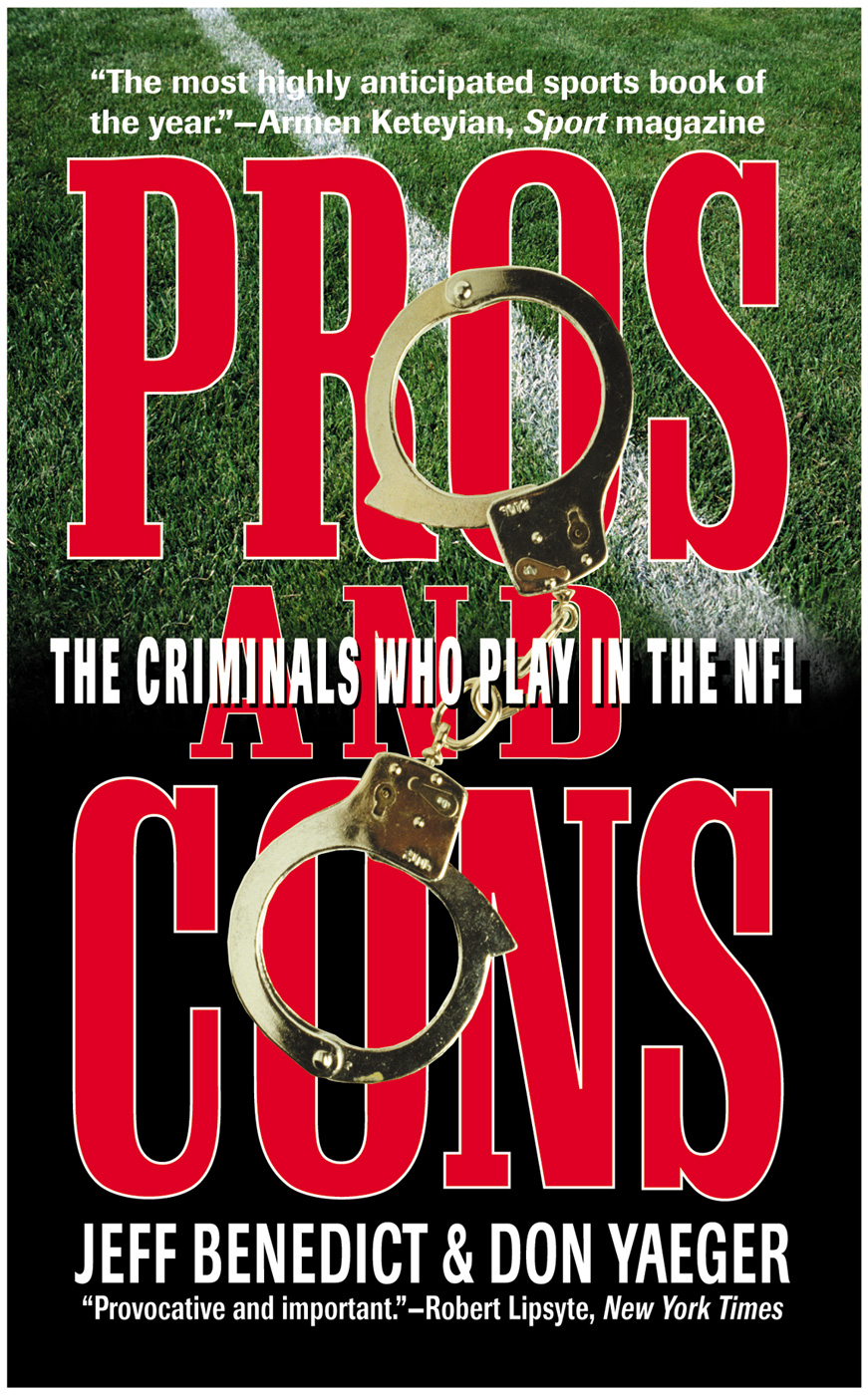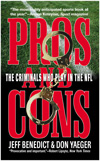Pros and Cons
Authors: Jeff Benedict,Don Yaeger


AND
CONS
JEFF BENEDICT & DON YAEGER

In accordance with the U.S. Copyright Act of 1976, the scanning, uploading, and electronic sharing of any part of this book without the permission of the publisher constitute unlawful piracy and theft of the author’s intellectual property. If you would like to use material from the book (other than for review purposes), prior written permission must be obtained by contacting the publisher at [email protected]. Thank you for your support of the author’s rights.
From day one, we never doubted that this book would hold people’s attention. But one moment stands out in our minds as the point when we knew how deep the problem of criminals in the NFL actually ran.
It was near the end of March in 1998. Both of us were on the road doing research in separate states. One of us went to a maximum security prison to interview an inmate who is an ex-NFL player doing forty-one years for ordering the murders of a judge and a witness who testified against the player in a federal drug trial. (That story is detailed later in the book.)
The other one of us was in a city where an NFL team is located. There an attractive woman, her hair tucked underneath a baseball cap, arrived for a prearranged private meeting. She wore an oversized coat and looked nervously over her shoulder out of fear that someone may have followed her there.
In a private location, the woman pulled from her purse a handheld tape recorder and a handful of minicassette tapes containing messages recorded off her home answering machine. With her permission, the author used his own tape recorder to record what she played back on hers.
The voice on the tape was that of her ex-husband, a player in the NFL today. The author felt the hair raising on his arms as he listened to death threats left by the player on the woman’s answering machine. He dared her to call the cops. He promised he would take her life. His abuse drove her to finally leave him.
After playing the tape for the author, the woman reached forward, her hand shaking terribly, and shut off the recorder. She was embarrassed, and so was the author.
“You can’t use my name or tell my story in your book,” the woman explained in a hushed tone. “If you do, he
will
kill me. I have no doubt of that. So I know I’ve taken a big risk in letting you hear these tapes, but I wanted you to understand how real this problem is. And I’m not the only woman. There are many others like me who go through this with these players.”
The particulars of this woman’s experience are not detailed in this book. Her name is not revealed either, nor is her ex-husband’s. But her disclosure to us and the wealth of other information she provided reinforced something we already had come to know all too well in the course of writing this book—there are an untold number of NFL players whose off-field character is in sharp contrast to the heroic persona projected on television.
There are a number of victims whose true names and identifying characteristics have been changed. (Pseudonyms are indicated by asterisks.) But in order to get you, the reader, beyond the made-for-TV image of these criminal players, there is little else that we have held back in our reporting. Thus this warning: the material contained on these pages is extremely graphic. Names are named and violent, sometimes heinous crimes are detailed. The final product, we confess, is not something we are putting on our mothers’ reading lists. Put simply, this is no book for the faint of heart.
We’ve written this way for a reason. You see, those responsible for the mayhem chronicled on these pages are no ordinary criminals. They are perceived as heroes. Rather than being stigmatized like most cons, these pros are cheered, idolized, and highly paid because they bring us thrills.
And we are not talking about just a few bad apples, here. Our research shows that 21 percent—one of every five—of the players in the NFL have been charged with a serious crime. How did we get that number?
The authors began in 1997 compiling a computerized list which identified the names of the approximately 1,590 players who played in the NFL during the 1996–97 season, then added the names of players from the 1997 draft. We then set out to identify how many of those players had a criminal record, a study never before undertaken. Three primary methods were used for checking players’ criminal histories.
First, we solicited records from state criminal repositories on players who resided in states where public information laws allow access to individuals’ criminal histories. For example, Florida, which has the most unrestricted public access laws in the nation, will make available upon written request and the payment of a nominal fee the complete criminal history of any individual who has been charged with a crime by any state or local police agency in the state.
After determining that a total of 480 NFL players from the 1996–97 season and 1997 draft class had resided in Florida at one time or another, we submitted all 480 names with attached birth dates to the Florida Department of Law Enforcement in Tallahassee. In return, we received approximately 100 pages of computer printouts identifying the names and crimes of every player among the 480 who had a record in the state of Florida. (We then contacted individual law enforcement agencies throughout Florida to obtain the actual police reports and court files on many of those cases.) A similar process was repeated in other states which allow public access, albeit more limited in scope than Florida, to an individual’s criminal history.
Second: in states which allow little or no access to criminal history information, we, where possible, performed county-by-county searches of the criminal court docket sheets in those states. This required, in some cases, going to a state and running players’ names and birth dates through public access computer terminals at municipal and district courthouses. In Seattle, for example, we ran approximately fifty names of players who had resided in Washington through a statewide computer database maintained at the King County District Court. In other instances, such as in Texas—home at one time or another to nearly 500 players who played during 1996–97—we relied on computer software which permits access to the criminal court docket listings in three of the state’s biggest counties: Dallas, Travis, and Bexar. The names and birth dates of all players were run through those databases. This method of identifying players who had been charged with a crime was used in Texas, Ohio, Minnesota, Michigan, Washington, and Georgia, as well as in California’s Los Angeles County.
Third: we contacted by telephone and written correspondence over forty-five police departments around the country seeking to obtain information on player arrests. Of the departments whose policies permit the release of such information, we then sent individual names and birth dates of players to the records’ clerks and in return received reports documenting players who had been charged with crimes in those jurisdictions.
Ultimately, of the approximately 1,590 NFL players from the 1996–97 season, there were 509 players (over a third of the entire league) whose criminal histories were sufficiently researched to form the sample base for this study. Relying on the methods explained above, any NFL player whose criminal history was either 1) checked by the authors in two states or more, or 2) cheeked in one state where the player resided for five years or longer made it into the sample. These criteria qualify our sampling as being random because the players in the survey group were chosen purely on the basis of record availability, a factor determined by state law.
“This selection criterion should be independent of whether any individual had an arrest history,” said Carnegie Mellon University Professor Alfred Blumstein, the nation’s leading expert on crime statistics, “and so the sample can be seen as reasonably representative of the players in the NFL.” (At our request, Professor Blumstein reviewed the research and provided a written review of our work. More of his analysis can be found in
Appendix I
.)
Of the 509 players in our study, an eye-popping 109 (21 percent) were found to have been formally charged (arrested or indicted) with a serious crime.
*
That’s right—one in five. (A complete break-down of the statistics is provided in Chapter I.)
While the statistics generated from the authors’ 509-player index provide the foundation for this book, they do not begin to tell the story. In fact, the numbers may actually be the bright side of the story.
In all, the authors reviewed over 400 reports of NFL players being formally charged with a crime. Over 625 interviews, many of which were tape-recorded, were conducted with individuals from the NFL (both players and coaches, past and present), law enforcement officials, judges, attorneys, crime victims, witnesses, physicians, jurors, sports agents, and scholars, among others, in order to better understand the cases and topics reported in this book. Additionally, the
authors reviewed over 120 criminal case files containing police reports, witness statements, affidavits, crime scene photographs, and medical evidence.
At no time, however, were private investigators used in the collection of data for this book—all research was done by the authors themselves or by paid legal researchers. Nor were any records or criminal history documents obtained that are not lawfully available through the proper filing of a public records request. In all, the authors filed over 100 such requests with law enforcement agencies and courts.
In the end, one conclusion rang true: NFL teams are recruiting a new breed of criminal players, the likes of which should disturb all NFL fans. Gone are the good old days of NFL recruits having rap sheets detailing merely drunken brawls and vandalism. In are the days of lethal violence, rape, armed robbery, home invasion, kidnapping, and drug dealing.
Although much of what is reported in this book will be news to readers, the same cannot be said for the league. All of the players whose crimes are chronicled in these pages had been deemed fit to play after undergoing intense investigation conducted by private investigators employed by the NFL and by individual teams’ scouts.
How do we know how good these investigators are? Consider: while collecting data for this book, the authors hired Northeastern University student J.R. Mastroianni to aid us in filing public records requests.
Several weeks into his work, Mastroianni had an unexpected visitor. A man showed up at Mastroianni’s fraternity house, a copy of the college student’s cable television bill in hand. When one of Mastroianni’s roommates told the man that the young research assistant was not there, the man identified himself as Larry Frisoli, left his phone number, and left instructions for Mastroianni to call him. When Mastroianni arrived at his fraternity house, his roommate told him that “a man from the cable company” had stopped by and left his number.

